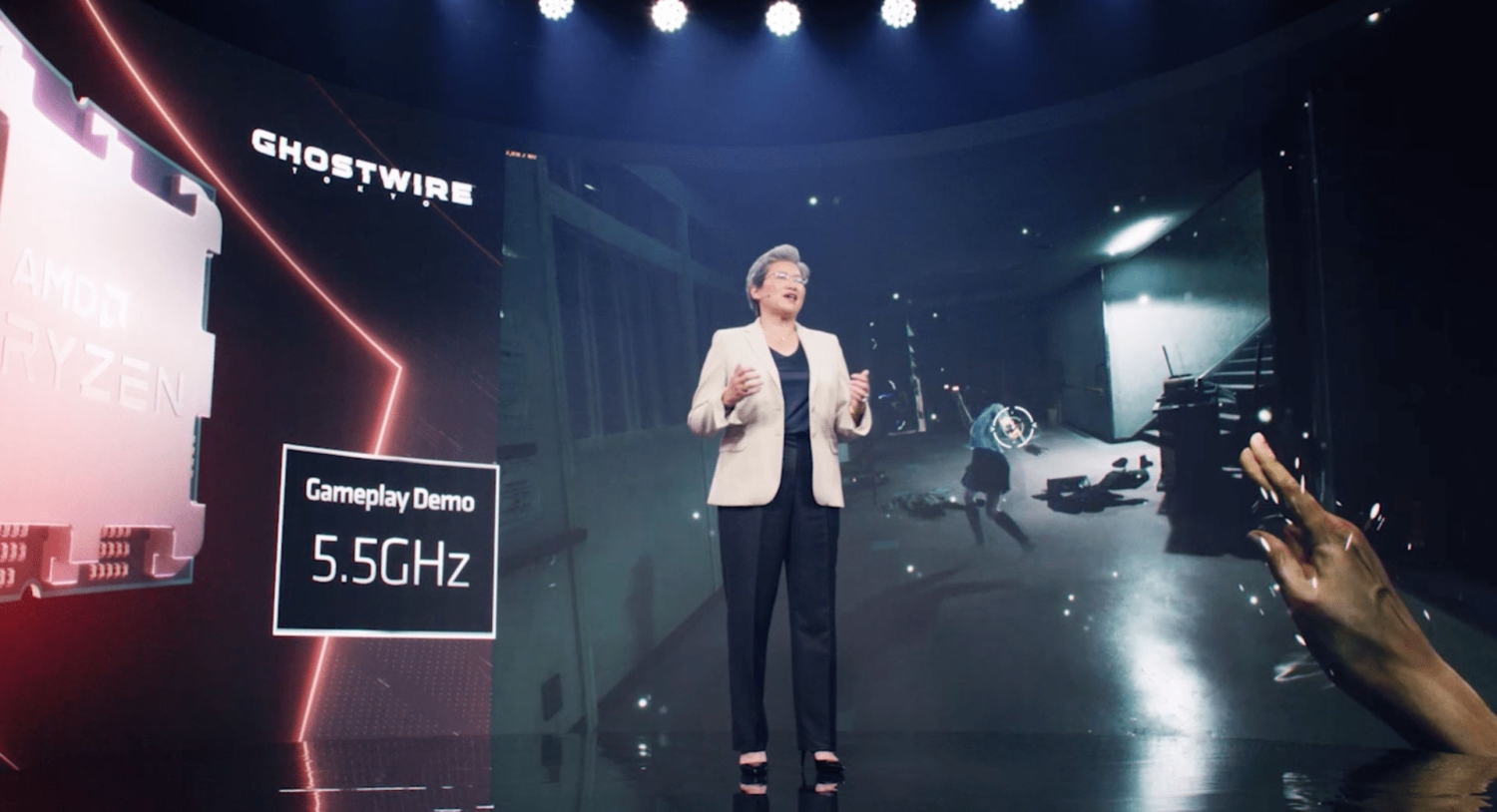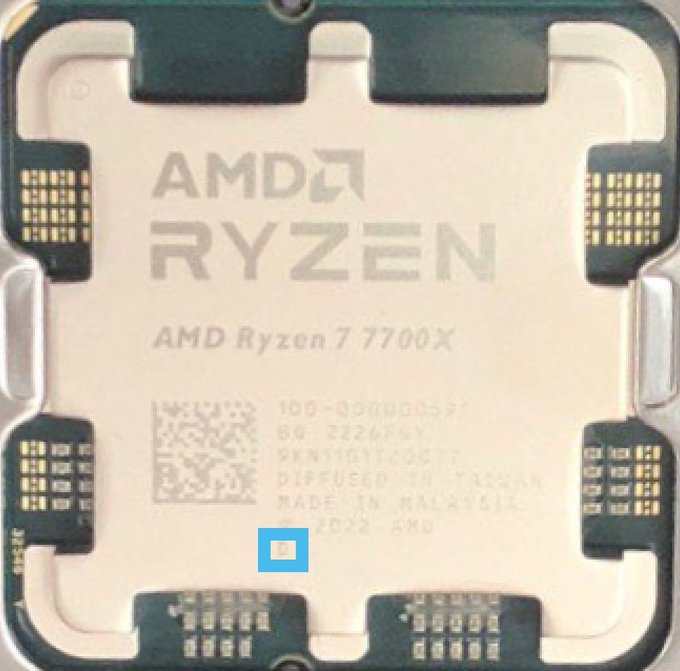Cinebench shows the base frequency which is why the 12600k also shows 3.7, so no the 7700X is not running locked at 4.5 if that's what you're trying to infer.Yep it matches it, 769 points at 5.1GHZ vs 773 points at 4.5GHz, total match there.
-
Competitor rules
Please remember that any mention of competitors, hinting at competitors or offering to provide details of competitors will result in an account suspension. The full rules can be found under the 'Terms and Rules' link in the bottom right corner of your screen. Just don't mention competitors in any way, shape or form and you'll be OK.
You are using an out of date browser. It may not display this or other websites correctly.
You should upgrade or use an alternative browser.
You should upgrade or use an alternative browser.
*** AMD "Zen 4" thread (inc AM5/APU discussion) ***
- Thread starter 4K8KW10
- Start date
More options
Thread starter's postsThe thing is we don't know if the 7700x was running stock or OC or anything as it doesn't state it. So for all we know it could have sat at 4.5Ghz or it could be at 5.5Ghz?Cinebench shows the base frequency which is why the 12600k also shows 3.7, so no the 7700X is not running locked at 4.5 if that's what you're trying to infer.
That is just sad. Expected, but sadSo the 7700X matches a 12600k, no wonder Intel feel they can raise prices on RPL.
AMD have gone from 2 generations ahead of Intel when Zen3 launched to a generation behind in the space of a couple of years.That is just sad. Expected, but sad
I don't actually mind AMD being behind though as it means hopefully we'll see Zen 2 pricing again and those were arguably AMDs best CPUs in the last 5 years in terms of price performance.
The 12600K was overclocked to 5.1ghz (default turbo is 4.9ghz). 5.1ghz is the turbo boost frequency of the 13600K, so it's very likely to give the same result in single core tests.That is just sad. Expected, but sad
I suspect there will be little overclocking headroom in Intel's 13th gen, at 5.8ghz on the 13900K, it sounds like they are already pushing Goldencove to it's limits (at least with sensible voltages and non exotic cooling).
Intel's 10ESF process has inherent voltage limitations (beyond which it will require huge amounts of power to achieve higher clocks, which is one of the reasons why they need an improved process like 7nm EUV /'Intel 4').
I think the 13900K will need a very high end cooling to reach 5.8ghz (just look at how the 12900K behaves over 5ghz), and may not be possible on all cores.
AMD keeping up with a 2nd gen optimized Intel architecture (achieving very high clocks, with 5ghz+ now standard on K CPUs), is a good thing.
I would be surprised if AMD haven't got some way to push some Zen 4 CPUs 300-400mhz higher than we've seen in current benchmarks. The IPC appears to be very similar between Zen 4 and Goldencove, so AMD will probably need some form of overclocking to compete with CPUs like the 13700K.
I suppose we will need to wait for the final specs of the 7900X and 7950X. I would expect that we can force 5.5ghz on all cores on Zen 4, based on this demo showing upto 5.5ghz at stock on Zen 4 with 16 cores:

AMD: yeah, our Zen 4 CPU '5.5GHz demo' was at stock, NO overclocking
AMD confirms its '5.5GHz' demo on Zen 4-powered Ryzen 7000 series CPU was at stock settings, and NOT overclocked a t all.
I wonder if the PPT of 230w is the absolute power limit of the socket, or will CPUs/motherboards be able to push beyond that?
Associate
- Joined
- 22 Feb 2019
- Posts
- 1,189
- Location
- Guernsey
Looks like I'll be delaying my AM5 upgrade until next year.
It doesn't make much sense to me forking out for a 7900X or 7950X on launch, not when the Vcache SKUs will release a few months later.
I mean the idea is to have a gaming rig that will out perform Raptor Lake, and this is what it's going to take to do that by the looks of it.
It doesn't make much sense to me forking out for a 7900X or 7950X on launch, not when the Vcache SKUs will release a few months later.
I mean the idea is to have a gaming rig that will out perform Raptor Lake, and this is what it's going to take to do that by the looks of it.
I can't help thinking that all the alleged performance results we've seen from the 12/16 core Zen 4 CPUs are either wrong, or just pure fabrications. Does anyone even have these models to test?
If we compare the Zen 3 5700X to the 5950X, there is a difference of 300mhz in boost clock speeds. That's about a 6% difference in clocks. It would be odd not to see something similar with Zen 4.
If we compare the Zen 3 5700X to the 5950X, there is a difference of 300mhz in boost clock speeds. That's about a 6% difference in clocks. It would be odd not to see something similar with Zen 4.
Associate
- Joined
- 7 Nov 2017
- Posts
- 2,001
yes because cinebench scores actually matter in the real world. Lets see how they do in games/content creation etc in actual reviews. cinebench is only useful for willy waving and hwbot.So the 7700X matches a 12600k, no wonder Intel feel they can raise prices on RPL.
Isn't cinebench what AMD themselves use to showcase their CPUs performance?yes because cinebench scores actually matter in the real world. Lets see how they do in games/content creation etc in actual reviews. cinebench is only useful for willy waving and hwbot.
Nag not really, they show it but spend more time focusing on games and blenderIsn't cinebench what AMD themselves use to showcase their CPUs performance?
Associate
- Joined
- 7 Nov 2017
- Posts
- 2,001
Isn't cinebench what AMD themselves use to showcase their CPUs performance?
couldn't tell you. Doesn't matter what cpu. Not used it since I set up PBO on my 3900x
Is it reasonable to assume that the 230w (PPT) part will be a 16 core CPU with V-cache?
Taking a look at the base clock of the 5800X3D (3.4ghz), it's 400mhz lower than the base clock of the 5800X, at the same tdp of 105w.
So, clearly the V-cache parts need more power to achieve the same clocks.
EDIT - Alternatively, it could just mean a 16 core V-Cache CPU would need to be clocked a bit lower.
Taking a look at the base clock of the 5800X3D (3.4ghz), it's 400mhz lower than the base clock of the 5800X, at the same tdp of 105w.
So, clearly the V-cache parts need more power to achieve the same clocks.
EDIT - Alternatively, it could just mean a 16 core V-Cache CPU would need to be clocked a bit lower.
There's always something the rumour mill misses, I wonder if it could be the '7800X' this time around?
Did anyone notice that userbenchmark (still) doesn't appear to support/list DDR5 RAM modules?
Only DDR4 modules listed, upto 3600 MT/s. I bet this is screwing up people's results on DDR5 systems...
Did anyone notice that userbenchmark (still) doesn't appear to support/list DDR5 RAM modules?
Only DDR4 modules listed, upto 3600 MT/s. I bet this is screwing up people's results on DDR5 systems...
Associate
- Joined
- 27 Jan 2022
- Posts
- 768
- Location
- UK
Notice the thermal paste on the package and components. We're gonna have to be more careful than whoever has this one. It might be fine as thermal paste doesn't conduct electricity(?) but still, if that were me I'd wanna clean that all off if it was like that.Someone posted this on Twitter:

Basically, the 'D' printed onto the IHS indicates this is a non retail model. Not sure if this could mean that the one used in the Cinebench R20 benchmark wasn't running at the final boost speeds?
It is tomorrow we get an update from AMD on stuff happening? I'm interested in what the new AM5 and how CPUs will perform, not interested enough to speculate on it, it's all just the usual hype train stuff.
Most use thermal paste thats none electrical conductive so dont see big issue , I always spread paste rarely see it fall off the edges so dont see any issue even if it did wont matter just when it comes to cleaning could be more work to clean it off cotton bud and IPA should be easy enough to use to clean , but people using paste thats conductive will have to be more careful might see something avaliable that fits into them open slots stopping anything dropping on the contacts
tomorrow AMD will show how it performs not sure when reviewers get to test it and show results
tomorrow AMD will show how it performs not sure when reviewers get to test it and show results
I've read some comments from AMD users, that the PPT is something that can be configured in the BIOS/uefi on AM4 boards. Does that mean that we will probably be able to increase this value above 230w, on X670 boards? Is it similar to a PL1 limit on Intel boards?
Edit - It looks like these are PBO settings that can be manually configured on AM4, is that correct?
Like so:

Edit - It looks like these are PBO settings that can be manually configured on AM4, is that correct?
Like so:
I've read some comments from AMD users, that the PPT is something that can be configured in the BIOS/uefi on AM4 boards. Does that mean that we will probably be able to increase this value above 230w, on X670 boards? Is it similar to a PL1 limit on Intel boards?
Edit - It looks like these are PBO settings that can be manually configured on AM4, is that correct?
Like so:

Yes, the PPT stands for Package Power Tracking, this is usually set to 142 Watts, unless you have a 65 Watt CPU, you can set it to whatever you like, tho i don't know how far it goes, 220 watts at least on AM4, its how you get 5950X's boosting to 4.8Ghz all core high load.
Not quite that simple since all core on mine sits at 4.3Ghz absolute.Yes, the PPT stands for Package Power Tracking, this is usually set to 142 Watts, unless you have a 65 Watt CPU, you can set it to whatever you like, tho i don't know how far it goes, 220 watts at least on AM4, its how you get 5950X's boosting to 4.8Ghz all core high load.
You can set it in ryzen master by way, no need to go into Bios for it. 250PPT is max I can set.


